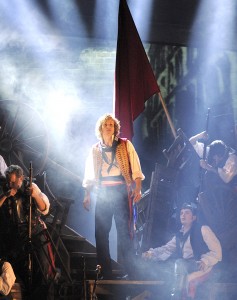Long-running musical epic takes L.A. by storm
It’s hard not to fall into the trap of playing the numbers game when discussing Les Misérables.

Seeds of change · Led by the charismatic intellectual Enjolras (Jeremy Hays), a band of students bent on revolution attempt to rally support for an insurrection using the death of a sympathetic government official. - Photo courtesy of Deen van Meer
The pride and joy of London’s West End has been translated into 21 different languages, has spawned 33 cast recordings and has seen productions staged in 291 cities in 42 countries. The show has played to more than 10,000 audiences in London alone since its 1985 opening, and with most performances weighing in at approximately three hours, the world’s longest running musical just so happens to also run pretty long. Most incredibly, it’s estimated some 55 million people globally have seen Les Mis in one incarnation or another.
But attempting to quantify this show’s greatness is a fool’s errand. You wouldn’t try to explain the appeal of a painting to someone who hadn’t seen it by giving the dimensions of the canvas; in much the same way, the power of the magnificent 25th anniversary production now playing at Downtown’s Ahmanson Theatre has to be seen — or felt, rather — first-hand.
Cameron Mackintosh — legendary producer of the original London version of Les Misérables as well as the only two other longer running Broadway musicals, Cats and The Phantom of the Opera — is again producing the show, the touring version of which is being hailed as a “spectacular new production.”
“Spectacular,” certainly: Matt Kinley’s elaborate sets make for an utterly immersive experience for theatergoers; co-directors Laurence Connor and James Powell’s inspired blocking and staging transported audiences from one unforgettable tableau to the next; as always, Claude-Michel Schönberg’s timeless music somehow manages to carry an emotional weight commensurate with the grand melodramas unfolding onstage.
“New,” however, is another matter. The cast certainly isn’t suffering from any shortage of Les Mis veterans — Justin Scott Brown (Marius), Michael Kostroff (Thénardier), Shawna M. Hamic (Madame Thénardier) and Jeremy Hays (Enjolras) all have prior experience with the show, and with this current production, J. Mark McVey is returning to the lead role of Jean Valjean for just about the 3,000th time (literally). None of the actors gave performances that felt stale in any way, only studied and familiar.
Vocally, the cast in residence at the Ahmanson holds its own against any of the great ensembles featured on the numerous cast recordings in circulation. As devoted distance-mother Fantine, Betsy Morgan delivers the show’s most famous number “I Dreamed A Dream” with all the vocal power and heartbreaking disappointment that audiences have come to expect from the song. Chasten Harmon as Éponine offers a subdued take on “On My Own” to great effect; even Hamic as the sleazy wife of a sleazier still drinking man backs up a consummate comedic performance with a strong vocal showing. And though it probably doesn’t bear saying at all, McVey as Valjean is unimpeachable.
Perhaps the most remarkable innovation in this quarter-centennial anniversary tour was, in fact, Kinley’s set design. Citing inspiration from the paintings of Victor Hugo, the 19th-century French author whose novel was the basis for the 123-years-subsequent musical, Kinley’s stylized background projections afforded the entire production a lush sensuality. The hazy delineations and watercolor effects were infinitely better suited to the show than any crisp Parisian scenic imagery would have been, but in any case, the rear wall projections enabled certain theatrical effects that wouldn’t be possible otherwise. Specifically, the technology allowed for more fully realized representations of motion when it was most needed. Instead of staring at a bloc of actors marching in place and having to will yourself to see a mob of Parisians who have taken to the streets, the receding cityscapes create an astonishingly effective illusion of just that.
In adapting the source material for the stage, librettist Alain Boublil committed some of the most egregious violations of Aristotle’s ‘classical unities’ — those being the unity of action, place and time — ever perpetrated against the ancient philosopher’s vision of what drama should be. The show’s epic scope completely obliterates the idea that the span of time covered in a play’s action should nearly approximate the play’s actual runtime, as well as the suggestion that one set representing one location is all that any audience should be asked to accommodate.
Of course, no fines are incurred from the dramatists’ guild for violations of Aristotle’s classical unities, but it’s worth pointing out — especially to those unfamiliar with the show — how thoroughly Les Mis breaks from those standards is one of its greatest delights. The sweeping tale spans nearly two decades and hops from one French location to the other in the course of telling Valjean’s lengthy game of cat-and-mouse with his single-minded pursuer, Inspector Javert (Andrew Varela), and the development of revolutionary sentiments in poverty-stricken France. Newcomers might be intimidated by the grand scale of the musical, but those who invest the necessary time and attention in this epic production of Les Misérables will almost certainly leave the theater as the joyful ones.


I am going next month – thank you for the great review. I was curious if this new version would hold up the great tradition.